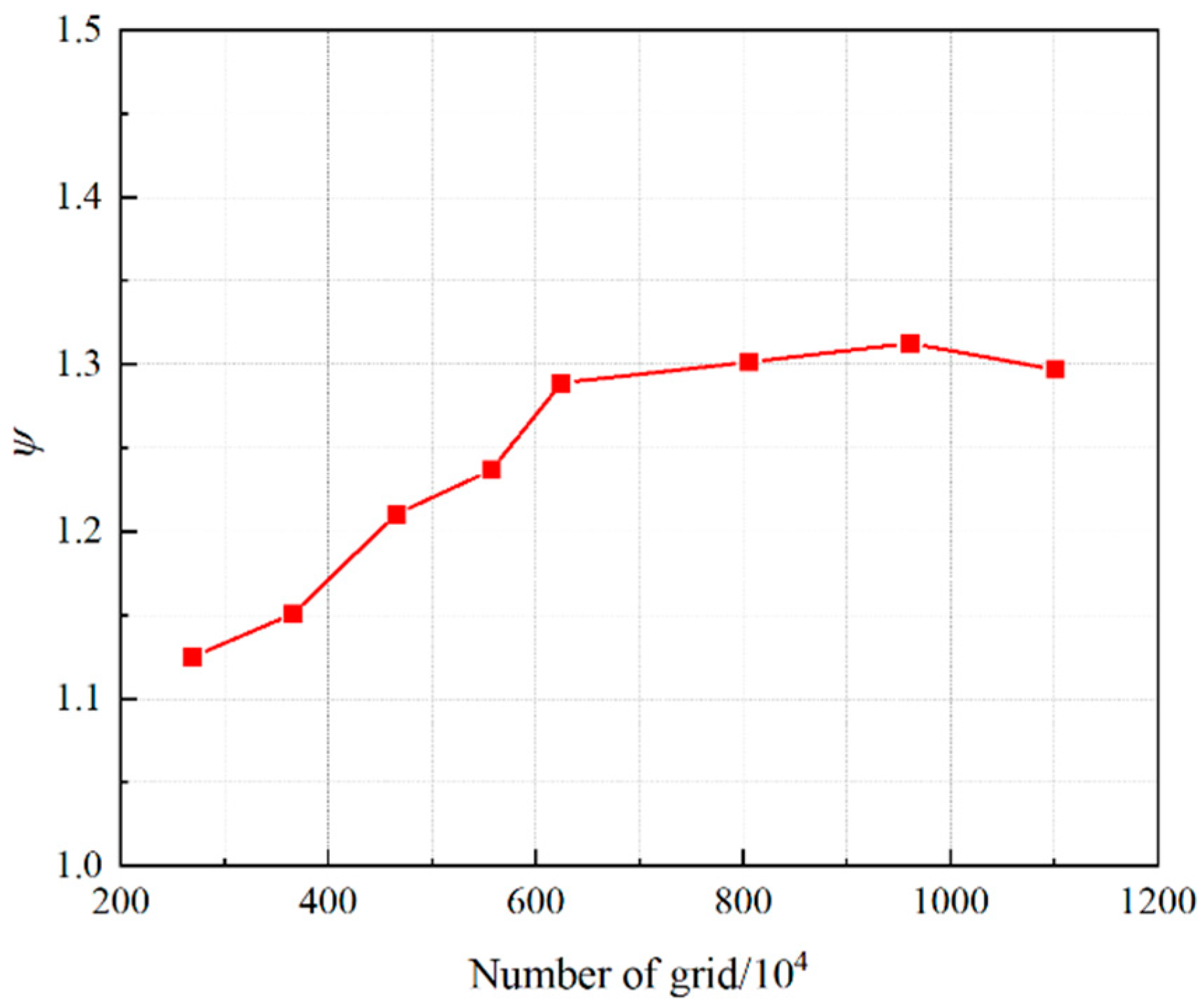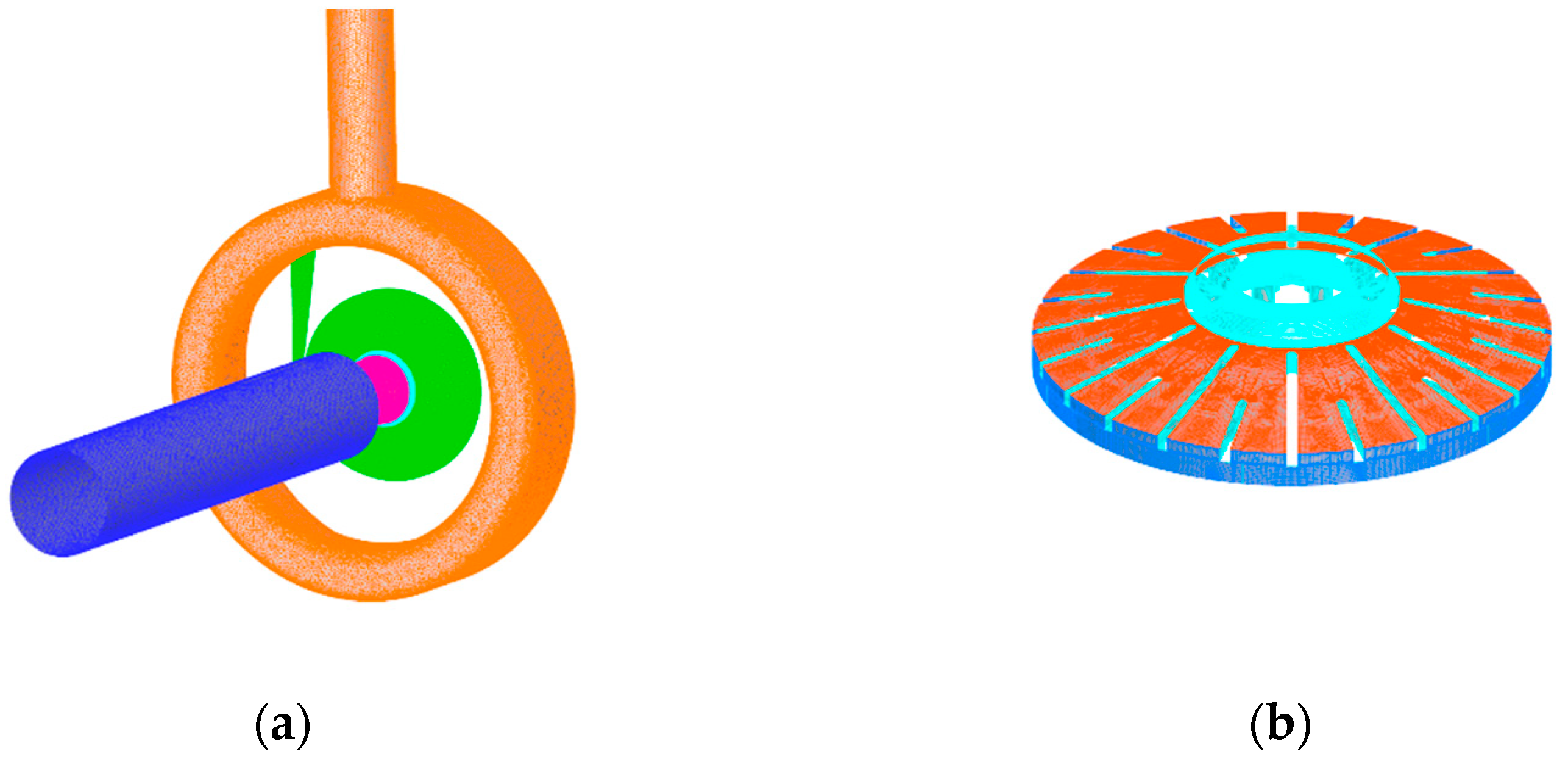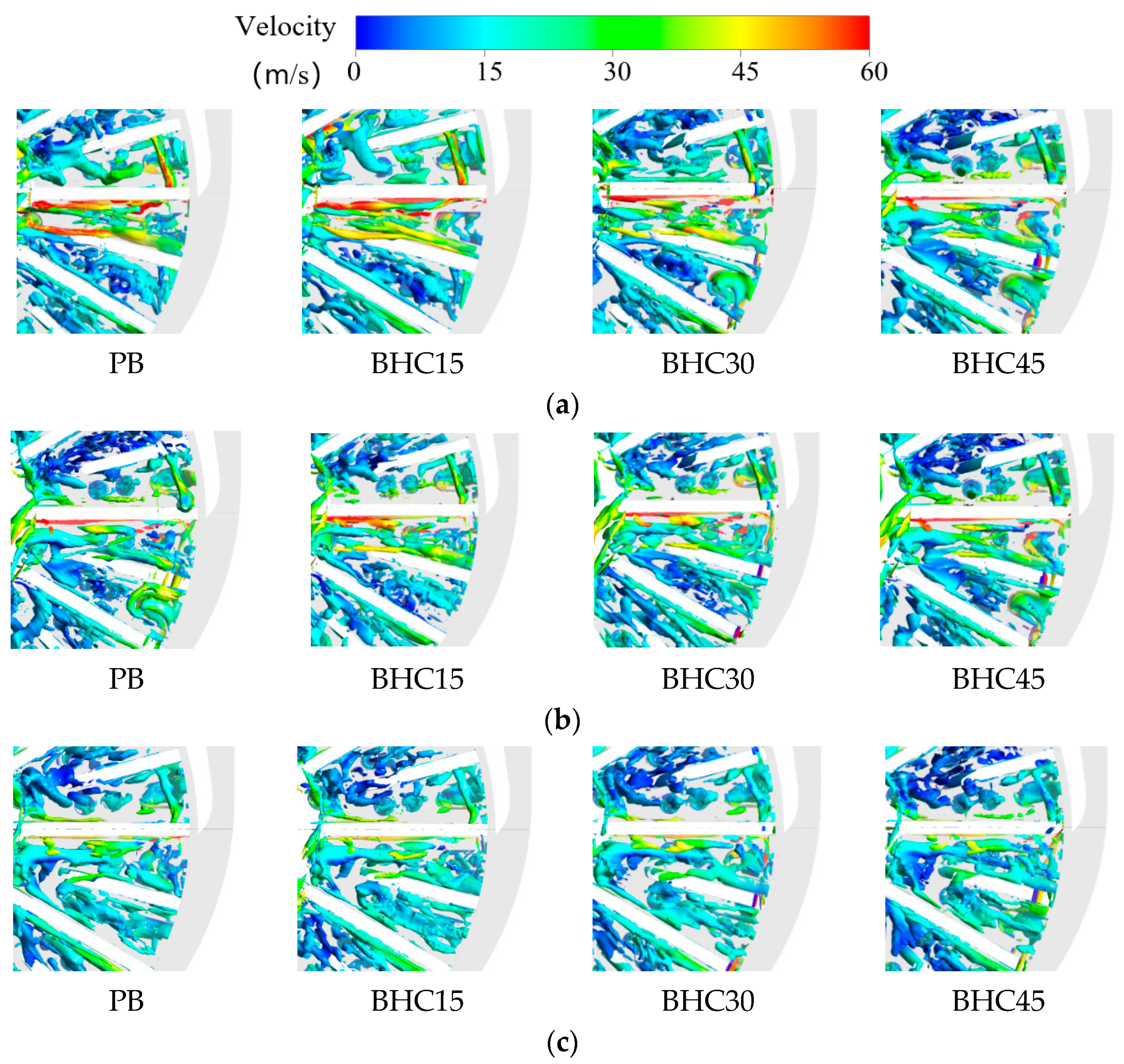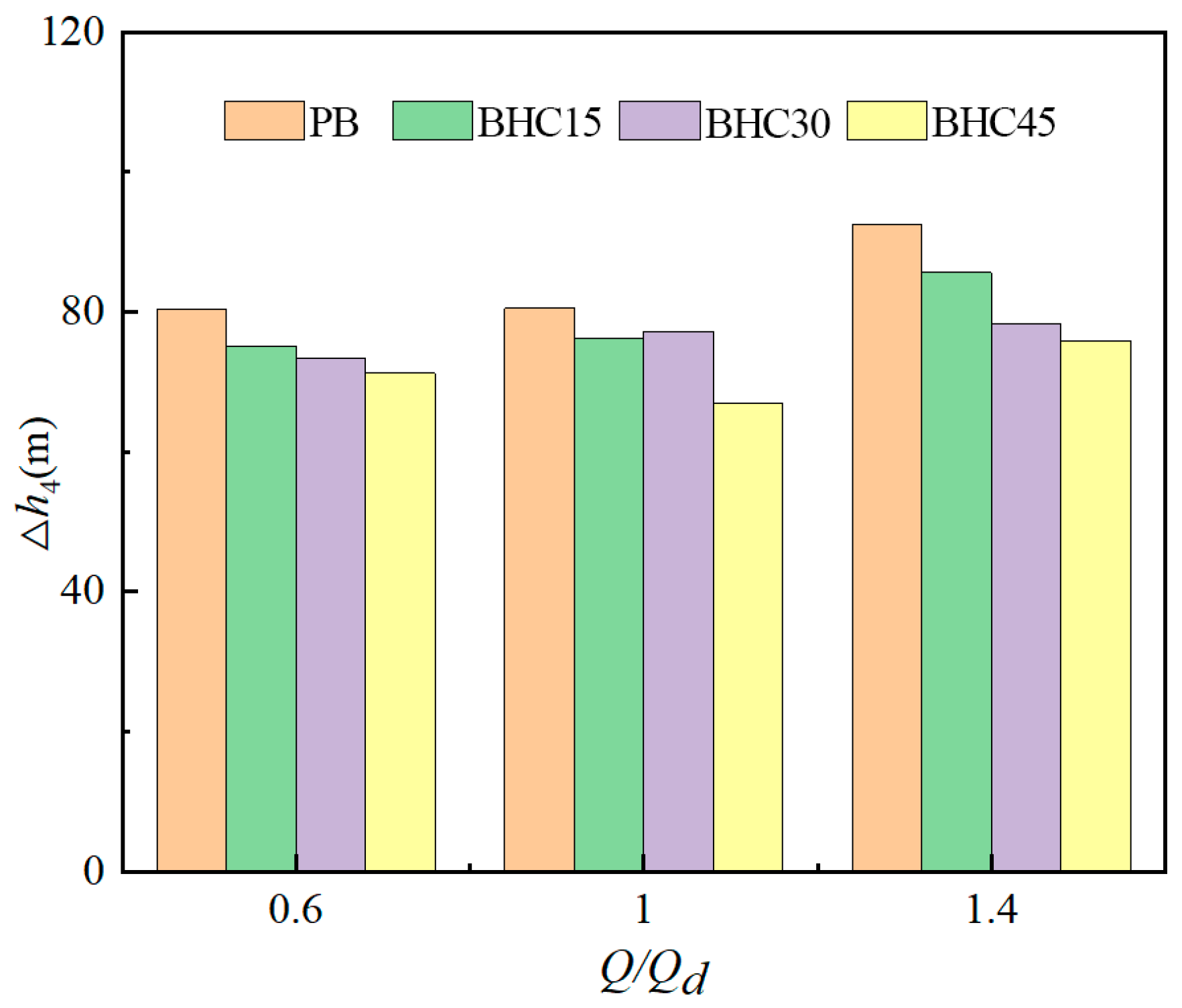Analysis of Unsteady Flow Characteristics Near the Cutwater by Cutting Impeller Hub in a High-Speed Centrifugal Pump
Abstract
:1. Introduction
2. Geometric and Mesh Generation
2.1. Geometric Model
2.2. Mesh Generation and Numerical Simulation Method
2.3. Eternal Characteristic Analysis
3. Internal Flow Analysis
3.1. Static Pressure Analysis
3.2. Vortex Distribution Analysis
3.3. Velocity Streamline Analysis
3.4. Pressure Pulsation Analysis
4. Hydraulic Loss Analysis
4.1. Impeller Passage Friction Loss
4.2. Dynamic and Static Interference Loss
5. Conclusions
- Cutting the hub of the impeller can improve the static pressure distribution and vortex distribution near the cutwater of the centrifugal pump. It also results in a more uniform velocity streamline distribution near the cutwater. Additionally, the modified centrifugal pump shows certain improvements in the Omega vortex distribution compared to the prototype pump PB.
- The modified centrifugal pump exhibits a reduced amplitude of pressure pulsation in the frequency domain compared to the prototype pump at various flow conditions. Cutting the hub of the impeller has a certain suppressive effect on the pressure pulsation at the cutwater of the centrifugal pump. In conclusion, cutting the hub of the impeller can enhance the performance of the centrifugal pump.
- By applying empirical formulas to calculate the hydraulic loss of the centrifugal pump, it was found that the impeller passage friction loss and the dynamic and static interference loss were the main sources of hydraulic loss. Cutting the hub of the impeller had a certain inhibitory effect on the hydraulic loss.
Author Contributions
Funding
Institutional Review Board Statement
Informed Consent Statement
Data Availability Statement
Conflicts of Interest
Nomenclature
| Qd | Design flow rate |
| Hd | Head |
| n | Rotating speed |
| ns | Specific speed |
| Z1 | Main blade |
| Ds | Pump inlet diameter |
| DO | Pump outlet diameter |
| D1 | Impeller inlet diameter |
| D2 | Impeller outlet diameter |
| b1 | Impeller Inlet width |
| b2 | Impeller Exit width |
| u2 | The velocity at the impeller outlet |
| P | The average static pressure at a certain section |
| Pin | The average static pressure at the impeller inlet section |
| ρ | The density of the fluid |
| Da | The average diameter |
| W1 | The relative velocities at the inlet of the impeller |
| W2 | The relative velocities at the outlet of the impeller |
| la | The length of the passage |
| Z | The number of impeller blades |
| λ | The friction resistance coefficient |
| Vm2 | The axial velocity at the impeller outlet |
| ns | The specific speed |
| Vs | The average velocity near the cutwater of the volute casing |
References
- Zhang, Y.; Song, D.; Wang, H.; Wang, X.; Jiang, L.; Wang, C.; Fan, M.; Zhao, J. Performance fluctuations and evaluation of a piston type integrated high pressure pump-energy recovery device. NPJ Clean. Water 2022, 5, 19. [Google Scholar] [CrossRef]
- Hou, H.; Zhang, Y.; Zhou, X.; Zuo, Z.; Chen, H. Optimal hydraulic design of an ultra-low specific speed centrifugal pump based on the local entropy production theory. Proc. Inst. Mech. Eng. Part A J. Power Energy 2019, 233, 715–726. [Google Scholar] [CrossRef]
- Hu, Q.; Chen, J.; Deng, L.; Kang, Y.; Liu, S. CFD-DEM Simulation of Backflow Blockage of Deep-Sea Multistage Pump. J. Mar. Sci. Eng. 2021, 9, 987. [Google Scholar] [CrossRef]
- Lu, J.; Yan, W.; Tao, R.; Wang, Z.; Zhu, D. Exploring the Mechanism of Strong-Pressure Fluctuation under Partial Load in the Turbine Mode of Pump Turbines for Hydro and Marine Power Storage. J. Mar. Sci. Eng. 2023, 11, 1089. [Google Scholar] [CrossRef]
- Jia, X.; Cui, B.; Zhu, Z.; Yu, X. Numerical investigation of pressure distribution in a low specific speed centrifugal pump. J. Therm. Sci. 2018, 27, 25–33. [Google Scholar] [CrossRef]
- Lin, Y.; Li, X.; Zhu, Z. An energy consumption improvement method for centrifugal pump based on bionic optimization of blade trailing edge. Energy 2022, 246, 123323. [Google Scholar] [CrossRef]
- Ji, L.; Li, W.; Shi, W. Effect of blade thickness on rotating stall of mixed-flow pump using entropy generation analysis. Energy 2021, 236, 121381. [Google Scholar] [CrossRef]
- Zhang, F.; Appiah, D.; Hong, F. Energy loss evaluation in a side channel pump under different wrapping angles using entropy production method. Int. Commun. Heat. Mass. 2020, 113, 104526. [Google Scholar] [CrossRef]
- Li, X.; Chen, B.; Luo, X. Effects of flow pattern on hydraulic performance and energy conversion characterization in a centrifugal pump. Renew. Energ. 2020, 151, 475–487. [Google Scholar] [CrossRef]
- Yang, Y.; Zhou, L.; Hang, J. Energy characteristics and optimal design of diffuser meridian in an electrical submersible pump. Renew. Energy 2021, 167, 718–727. [Google Scholar] [CrossRef]
- Hirano, T.; Guo, Z.; Kirk, R.G. Application of computational fluid dynamics analysis for rotating machinery—Part ii: Labyrinth seal analysis. J. Eng. Gas. Turbines Power 2005, 127, 820–826. [Google Scholar] [CrossRef]
- Byskov, R.K.; Jacobsen, C.B.; Pedersen, N. Flow in a centrifugal pump impeller at design and off-design conditions—Part II: Large eddy simulations. J. Fluids Eng. 2003, 125, 73–83. [Google Scholar] [CrossRef]
- Li, H.; Chen, Y.; Yang, Y.; Wang, S.; Bai, L.; Zhou, L. CFD Simulation of Centrifugal Pump with Different Impeller Blade Trailing Edges. J. Mar. Sci. Eng. 2023, 11, 402. [Google Scholar] [CrossRef]
- Wang, L.-k.; Lu, J.-l.; Liao, W.-l.; Guo, P.-c.; Feng, J.-j.; Luo, X.-q.; Wang, W. Numerical investigation of the effect of T-shaped blade on the energy performance improvement of a semi-open centrifugal pump. J. Hydrodyn. 2021, 33, 736–746. [Google Scholar] [CrossRef]
- Qu, X.; Wang, L. Effects of impeller trimming methods on performances of centrifugal pump. J. Energ. Eng. 2016, 142, 04016008. [Google Scholar] [CrossRef]
- Ding, H.; Li, Z.; Gong, X. The Influence of Blade Outlet Angle on the Performance of Centrifugal Pump with High Specific Speed. Vacuum 2019, 159, 239–246. [Google Scholar] [CrossRef]
- Liu, H.; Jiang, L.; Wang, Y. Optimization and CFD performance analysis of an automotive coolant pump. Adv. Mech. Eng. 2022, 14, 16878132221081602. [Google Scholar] [CrossRef]
- Gu, Y.; Sun, H.; Wang, C.; Lu, R.; Liu, B.; Ge, J. Effect of Trimmed Rear Shroud on Performance and Axial Thrust of Multi-Stage Centrifugal Pump with Emphasis on Visualizing Flow Losses. ASME. J. Fluids Eng. 2024, 146, 011204. [Google Scholar] [CrossRef]
- Ji, D.; Lu, W.; Lu, L.; Xu, L.; Liu, J.; Shi, W.; Huang, G. Study on the Comparison of the Hydraulic Performance and Pressure Pulsation Characteristics of a Shaft Front-Positioned and a Shaft Rear-Positioned Tubular Pump Devices. J. Mar. Sci. Eng. 2022, 10, 8. [Google Scholar] [CrossRef]
- Shang, L.; Cao, J.; Wang, L.; Yu, S.; Ding, S.; Wei, Z.; Wang, Z.; Liu, X. Analysis of Flow and Runner Dynamic Response Characteristics under Pump Conditions of Variable-Speed Pump Turbine. J. Mar. Sci. Eng. 2023, 11, 1493. [Google Scholar] [CrossRef]
- Li, Y.; Su, H.; Wang, Y.; Jiang, W.; Zhu, Q. Dynamic Characteristic Analysis of Centrifugal Pump Impeller Based on Fluid-Solid Coupling. J. Mar. Sci. Eng. 2022, 10, 880. [Google Scholar] [CrossRef]
- Yan, P.; Chu, N.; Wu, D. Computational fluid dynamics-based pump redesign to improve efficiency and decrease unsteady radial forces. J. Fluid. Eng. 2016, 139, 011101. [Google Scholar] [CrossRef]
- Luo, Z.-Y.; Feng, Y.; Sun, X.-Y.; Gong, Y.; Lu, J.-X.; Zhang, X.-W. Research on the Unsteady Flow and Vortex Characteristics of Cavitation at the Tongue in Centrifugal Pump. J. Appl. Fluid. Mech. 2024, 17, 646–657. [Google Scholar] [CrossRef]
- Qixiang, H.; Yang, Y.; Weidong, S.; Weidong, C.; Yansheng, S. Cavitating Flow in the Volute of a Centrifugal Pump at Flow Rates Above the Optimal Condition. J. Mar. Sci. Eng. 2021, 9, 446. [Google Scholar] [CrossRef]
- Peng, G.; Lou, Y.; Yu, D.; Hong, S.; Ji, G.; Ma, L.; Chang, H. Investigation of Energy Loss Mechanism and Vortical Structures Characteristics of Marine Sediment Pump Based on the Response Surface Optimization Method. J. Mar. Sci. Eng. 2023, 11, 2233. [Google Scholar] [CrossRef]
- Zhang, N.; Yang, M.; Gao, B. Experimental and numerical analysis of unsteady pressure pulsation in a centrifugal pump with slope volute. J. Mech. Sci. Technol. 2015, 29, 4231–4238. [Google Scholar] [CrossRef]
- Jiang, W.; Li, G.; Liu, P. Numerical investigation of influence of the clocking effect on the unsteady pressure fluctuations and radial forces in the centrifugal pump with vaned diffuser. Int. Commun. Heat. Mass. 2016, 71, 164–171. [Google Scholar] [CrossRef]
- Lu, J.; Luo, Z.; Chen, Q.; Liu, X.; Zhu, B. Study on pressure pulsation induced by cavitation at the tongue of the volute in a centrifugal pump. Arab. J. Sci. Eng. 2022, 47, 16033–16048. [Google Scholar] [CrossRef]
- Ding, H.; Ge, F.; Wang, K.; Lin, F. Influence of Blade Trailing-Edge Filing on the Transient Characteristics of the Centrifugal Pump during Startup. Processes 2023, 11, 2420. [Google Scholar] [CrossRef]
- Cui, B.; Liu, J.-X.; Zhai, L. Analysis of the performance and pressure pulsation in a high-speed centrifugal pump with different hub-cutting angles. Mod. Phys. Lett. B 2023, 37, 2350117. [Google Scholar] [CrossRef]
- Cui, B.; Chen, H.; Zhu, Z.; Sun, L.; Sun, L. Optimization of low-temperature multi-stage submersible pump based on blade load. Phys. Fluids 2024, 36, 035157. [Google Scholar] [CrossRef]
- Cui, B.; Zhang, C.; Zhang, Y.; Zhu, Z. Influence of Cutting Angle of Blade Trailing Edge on Unsteady Flow in a Centrifugal Pump Under Off-Design Conditions. Appl. Sci. 2020, 10, 580. [Google Scholar] [CrossRef]
- Wang, C.; Yao, Y.; Yang, Y.; Chen, X.; Wang, H.; Ge, L.; Cao, W.; Zhang, Q. Automatic optimization of centrifugal pump for energy conservation and efficiency enhancement based on response surface methodology and computational fluid dynamics. Eng. Appl. Comp. Fluid. 2023, 17, 2227686. [Google Scholar] [CrossRef]













| Parameter | Value |
|---|---|
| Design flow rate (m3/h) | 12 |
| Head (m) | 2153 |
| Rotating speed (r/min) | 23,350 |
| Specific speed | 82.3 |
| Main blade | 12 |
| Pump inlet diameter(mm) | 82 |
| Pump outlet diameter (mm) | 50 |
| Impeller inlet diameter (mm) | 54 |
| Impeller outlet diameter (mm) | 140 |
| Impeller inlet width (mm) | 10 |
| Impeller exit width (mm) | 4 |
| Experimental Number | Experimental Head Coefficient |
|---|---|
| 1 | 1.275 |
| 2 | 1.289 |
| 3 | 1.265 |
| 4 | 1.296 |
| 5 | 1.25 |
Disclaimer/Publisher’s Note: The statements, opinions and data contained in all publications are solely those of the individual author(s) and contributor(s) and not of MDPI and/or the editor(s). MDPI and/or the editor(s) disclaim responsibility for any injury to people or property resulting from any ideas, methods, instructions or products referred to in the content. |
© 2024 by the authors. Licensee MDPI, Basel, Switzerland. This article is an open access article distributed under the terms and conditions of the Creative Commons Attribution (CC BY) license (https://creativecommons.org/licenses/by/4.0/).
Share and Cite
Cui, B.; Shi, M. Analysis of Unsteady Flow Characteristics Near the Cutwater by Cutting Impeller Hub in a High-Speed Centrifugal Pump. J. Mar. Sci. Eng. 2024, 12, 587. https://doi.org/10.3390/jmse12040587
Cui B, Shi M. Analysis of Unsteady Flow Characteristics Near the Cutwater by Cutting Impeller Hub in a High-Speed Centrifugal Pump. Journal of Marine Science and Engineering. 2024; 12(4):587. https://doi.org/10.3390/jmse12040587
Chicago/Turabian StyleCui, Baoling, and Mingyu Shi. 2024. "Analysis of Unsteady Flow Characteristics Near the Cutwater by Cutting Impeller Hub in a High-Speed Centrifugal Pump" Journal of Marine Science and Engineering 12, no. 4: 587. https://doi.org/10.3390/jmse12040587





